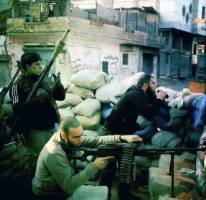As violence appears to have escalated in Syria, the BBC's Ian Pannell reports on the situation in the north of the country, where he has just spent the last two weeks with some of the opposition fighting groups in Idlib province.
The commander had "gone to ground" and we sat for endless tense hours in a breathless heat waiting for news.
For two weeks, we watched the Idlib Martyrs Brigade plan operations against the military and shabiha militias, but we had witnessed only a handful of them, hearing vague rumors of something "bigger" in the offing.
One fighter stopped by to see us, but he, like everyone else, refused to tell us what was happening.
For all their flaws, secrecy is one area where the opposition fighters are disciplined, but the hint we craved was there: "If you don't see the commander for ages, it means he's planning something big," he said.
Two hours later, a truck arrived, and we were bustled on board and driven to a remote farmhouse.
Not only was the operation happening, but also it was large, ambitious, and we were to see the biggest group of fighters we have ever seen in a year of travelling surreptitiously into northern Syria.
Dozens became scores became hundreds, armed with Kalashnikov rifles and rocket-propelled grenades (RPGs), homemade hand grenades and IEDs (improvised explosive devices). The fighters advanced towards a military checkpoint and base in Armanaz.
What followed was an intense firefight - bullets and tank rounds searing overhead as the fighters tried and ultimately failed to overrun the base.
An official government press release said "terrorist gangs" had swarmed the town and that dozens of fighters were killed. We witnessed only one fatality amongst the fighters and a handful of injuries.
Popular support
What it showed though is that the Free Syrian Army (FSA) is becoming more capable, more organized and more coherent than we have seen before.
The Idlib Martyrs Brigade is a confederation of 12 battalions and hundreds of fighters, and it now coordinates attacks with other groups in the north.
For now, the Assad government has lost effective control of vast swathes of Idlib province and parts of Aleppo province in the north. The key word is "effective". This is still a comparative shift rather than a sea change, and it is certainly not irreversible.
The government can redeploy large numbers of troops where it wants (although no doubt at the risk of leaving other areas exposed); it can shell from afar with impunity (which was a daily occurrence); it controls the skies, and when helicopter gunships are up, the opposition fighters have to hide. And key urban centers like Idlib and Aleppo are under its firm grip, albeit with a limited FSA presence.
But in practice, these rural areas are too large and the population centers too spread out for the government to effectively control it all.
The opposition fighters know every inch of this land, the millions of acres of fields and olive groves and the dirt tracks. And their increasingly large network provides real-time intelligence on troop movements.
Perhaps most importantly, they appear to enjoy the sympathy of much of the local population.
As the government attempts to extinguish fires in 1,000 places, it bears some similarities to watching the British and American fight against the Taliban in Afghanistan.
When the FSA is squeezed hard in one area, it simply moves to another and quickly moves back to reclaim unoccupied land as government forces move elsewhere.
The armed opposition has received some new weapons.
What we did see was some new weapons, a few heavier machine guns, more ammunition and a lot of homemade ordnance.
One commander told us he was now able to buy small arms from "the mafia", although their ability to do so is limited by a lack of funds. But borders that once limited the movement of men and munitions now certainly appear to be more porous.
The FSA knows it is infinitely weaker than the enemy it faces, so it is starting to embrace the tactics of asymmetric guerrilla warfare.
In Aleppo and Idlib provinces, the fighting is escalating, with unverified reports from activists that more than 200 people were killed in clashes and attacks over the last weekend alone.
Tactics are not just evolving; they are becoming more ruthless.
Last Friday, regime officials accused the opposition fighters of carrying out a massacre in Darat Izza, abducting, killing and mutilating 25 men. Activists said they were shabiha militiamen.
It is difficult to know how this ends, but more violence, death and suffering is inevitable.
PHOTO CAPTION
Free Syria Army checkpoint in Baba Amr district of Homs
Source: BBC


 Home
Home Discover Islam
Discover Islam Quran Recitations
Quran Recitations Lectures
Lectures
 Fatwa
Fatwa Articles
Articles Fiqh
Fiqh E-Books
E-Books Boys & Girls
Boys & Girls  Articles
Articles










